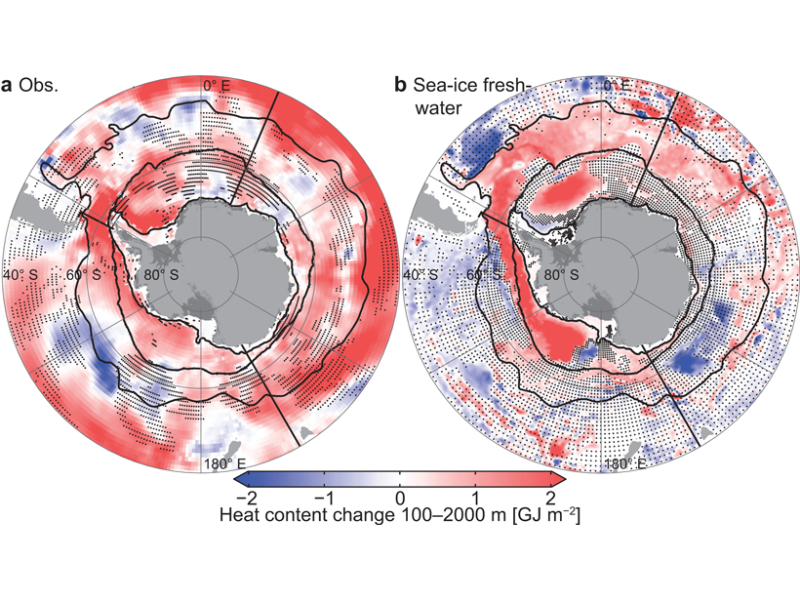Explaining Cold and Fresh Southern Polar Ocean Surface Waters
Global climate models do not reproduce observed trends of the Southern polar ocean surface, but an increase in wind-transported sea ice that melts and inhibits mixing may account for the disparity.
SOURCE: AGU Advances

Observed (left) subsurface (110-2000 m) ocean heat content changes from 1982 to 2011 and simulated (right) subsurface heat content change (years 6 to 15) in response to sea-ice freshwater flux perturbation. Credit: Haumann et al. [2020], Figure 7a and b
Most of the global ocean surface has been warming in response to increased greenhouse gases concentrations. One notable exception is the ocean south of 50 degrees south which, from the early 1980s to the early 2010s, has become colder/fresher in the upper 100 meters and warmer below. Various hypotheses have been proposed to explain this trend, among them a) increased glacial meltwater input due to ice shelf thinning, and b) increased northward transport of cold waters in response to the observed poleward shift of the southern-hemisphere westerlies.
Haumann et al. [2020] propose a further hypothesis of increased northward transport of sea ice over that period. The team carried out a suite of numerical simulations using a regional ocean model to investigate the three hypotheses by separately increasing sea-ice fluxes, freshwater input from the Antarctic continent and ocean-atmosphere momentum input by winds.
The observational trends are best reproduced in the simulations with increased lateral sea-ice transport. The underlying process is elucidated, leading to freshening/cooling of the surface waters and warming of the subsurface layer. This warming has important climate implications because the heat trapped in the subsurface accounts for approximately 8 percent of the global ocean heat content increase over that time period.
Citation: Haumann, F.A., Gruber, N., & Münnich, M. [2020]. Sea-ice Induced Southern Ocean Subsurface Warming and Surface Cooling in a Warming Climate. AGU Advances, 1, e2019AV000132. https://doi.org/10.1029/2019AV000132
—Paola Rizzoli, Editor, AGU Advances
AGU发布最新国外工作学习机会:
1. Graduate Student Positions (Master's or PhD Opportunities)
Guelph, Ontario (CA)
University of Waterloo
We invite applications for three graduate student positions to participate in a research project to evaluate the resilience of diversified crop rotations to extreme weather events such as intense precipitation and freeze-thaw cycles in Canadian agroecosystems.
https://findajob.agu.org/job/8012226/graduate-student-positions-master-s-or-phd-opportunities-/
2. Funded MS/PhD and Postdoc Opportunities in Geological Engineering
Full tuition and competitive stipend
Missouri S&T GGPE
Starting fall 2020
3. TWO Fully Funded PhD Scholarships Available in Earth Sciences
Adelaide and Perth, Australia
Fully funded, including stipend of 28,000$ p.a. for 3 years
University of Adelaide (Department of Earth Sciences)
Interested in delving into deep time? Two Australian PhD scholarships are funded to develop the mineral apatite as a probe of crustal evolution.
4. Postdocs/Post Master's for Wisconsin Water Resources Science-Policy Fellowship (Hydrology/Fisheries)
Madison, Wisconsin
Post Master's - $40,000/Postdocs - $55,000/with additional benefits
Wisconsin Sea Grant College Program
5. Post-Doctoral Fellow in Geodynamics and Geoselenic Research
Kingston, Ontario
$60,000/year
Queen's University - Geological Sciences & Geological Engineering
The Stephen Cheeseman Geoselenic Research Project was established in 2020 to address fundamental questions about the interactions within the Earth-Moon system.
https://findajob.agu.org/job/8012208/post-doctoral-fellow-in-geodynamics-and-geoselenic-research/



